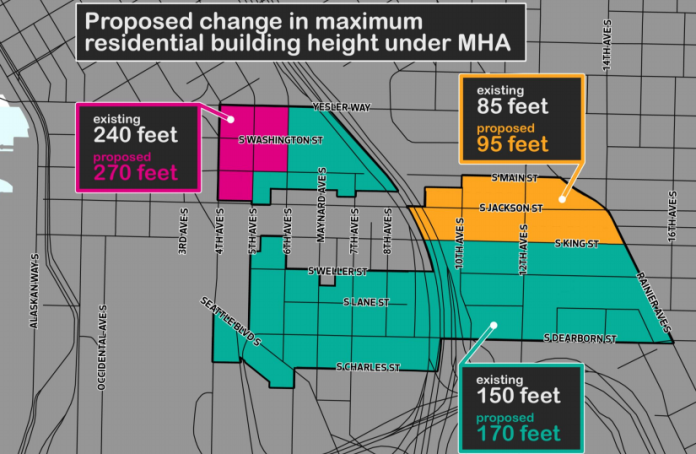On Monday, the Seattle City Council passed significant legislation affecting Downtown zones. Most areas of Chinatown-International District received a comprehensive rezone increasing building heights and allowed floor area. A supplementary resolution to the Chinatown-International District passed, providing additional guidance and intent for the neighborhood following the rezone. A new incentive to encourage tower separation from existing residential towers in the Downtown Office Core 2 zone was also added to the Land Use Code. Separately, the City Council authorized the future sale of Seattle City Light-owned property in South Lake Union.
Chinatown-International District Rezone
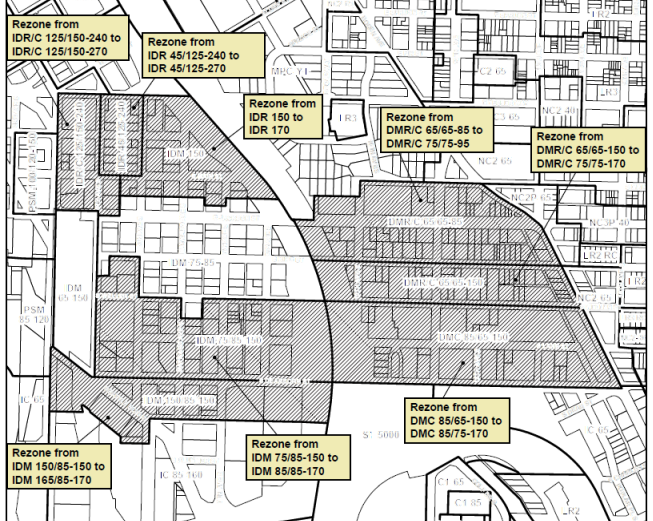
The bulk of the Chinatown-International District rezone proposal approved by the City Council remained the same from the one we detailed in June. The rezone allows slightly taller and wider buildings while pairing mandatory requirements for affordable housing for most new commercial and residential development.
- Under the terms of the rezone, developers will generally be expected to set aside 5% to 7% of their developments for affordable housing or pay a fee to City for affordable housing.
- Commercial development capacity is generally increased by 0.5 to 1.0 FAR (floor area ratio). In some cases, capacity increases in terms of allowed building heights. Meanwhile, residential development capacity is increased by building heights, ranging from 10 to 30 feet, depending upon zone. In zones where towers are permitted, certain floorplate maximums are slightly modified to account for what are considered “breakpoints” in development capacity and cost.
- Large voluntary affordable housing projects in the Chinatown-International District will be exempt from mandatory participation in incentive zoning programs for any additional floor area above the base maximum allowed in the DMC, DMR, IDM, and IDR zones of South Downtown. These projects must receive public funding or Low-Income Housing Tax Credits from the federal government, have a minimum of 40% of all units income-restricted to households making at or below 60% of the area median income, and serve as affordable housing for at least 40 years either by covenant or other recorded property agreement with a local, state, or federal agency.
- The rezone retains existing incentive zoning requirements, such as contributions to Green Street improvements, preservation of open space and historic landmarks, development of privately-owned public spaces (e.g., public open space, public atriums, human services uses, and public restrooms), and developing affordable housing.
- The rezone will result in the Downtown Design Review Board being extended to cover all of Chinatown-International District taking in portions currently managed by the East and Southeast Design Review Boards.
- Another change from the rezone will expand the International Special Review District to also cover all of Chinatown-International District, allowing that body to effectuate common design guidance and special planning control across the whole neighborhood.
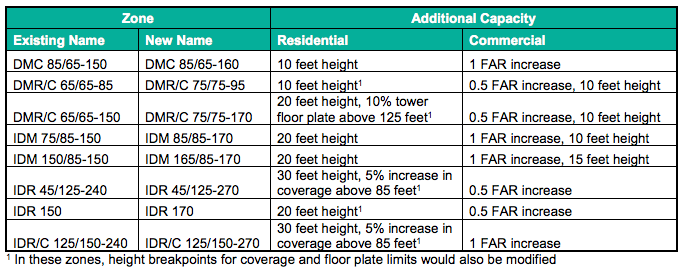
While changes had been made to the rezone earlier in the Council review process, the last biggest changes came in the form of incentives for family-sized units and on-site affordable housing:
- In order to incentivize construction of family-sized units, an extra 10 feet of building height would be allowed above the maximum height limit for residential uses in most Downtown zones. The incentive would available in all Downtown zones except the IDM 75-85 (which is in the heart of historic Chinatown), PMM-85, DH1, DH2, and PSM zones. At least 10 family-sized units would have to be constructed in a development to qualify for the additional building height with each unit containing a minimum of 900 square feet and three bedrooms. Each dwelling unit would also be required to have direct access to an outdoor amenity area on the same floor. These kinds of spaces can contain a mixture of shared and private space, though at least 60% would need to be commonly available to units and have play equipment in it designed for children.
- In most Chinatown-International District zones, an incentive for an additional 10 feet of building height above the maximum height limit for residential uses would be available in exchange for constructing deeply affordable housing units on-site. The incentive is targeted at creating rental housing units that are greater than 400 square feet in size for households at or below 50% of the area median income (AMI) using standard unit design requirements specified in the Mandatory Housing Affordability-Residential (MHA-R) provisions. Monthly rent for any household could not exceed 30% of the 50% AMI. At least 10 dwelling units would need to meet this standard. Doing so would exempt both the additional 10 feet of building height and deeply affordable on-site housing units from the certain MHA-R calculations. The incentive applies to the DMC 85/75-170, DMR/C 75/75-95, DMR/C 75/75-170, IDM 85/85-170, IDM 165/85-170, IDR/C 125/150-270, and IDR 45/125-270 zones.
The two incentives described above are mutually exclusive; a developer can only use one, not both to achieve additional building height.
A companion resolution to the neighborhood rezone also passed, outlining specific actions for the City to follow-up on. The resolution highlights a wide variety of topics, including: revisions to local design guidelines, limits on the size of storefronts, requirements for reporting on investments and programs in the community to the City Council, limits on chain stores, and exploration of a possible pilot program for Unreinforced Masonry Preservation that would increase the supply of affordable housing on currently-vacant upper floors of buildings.
DOC2 Incentive for Voluntary Tower Setbacks
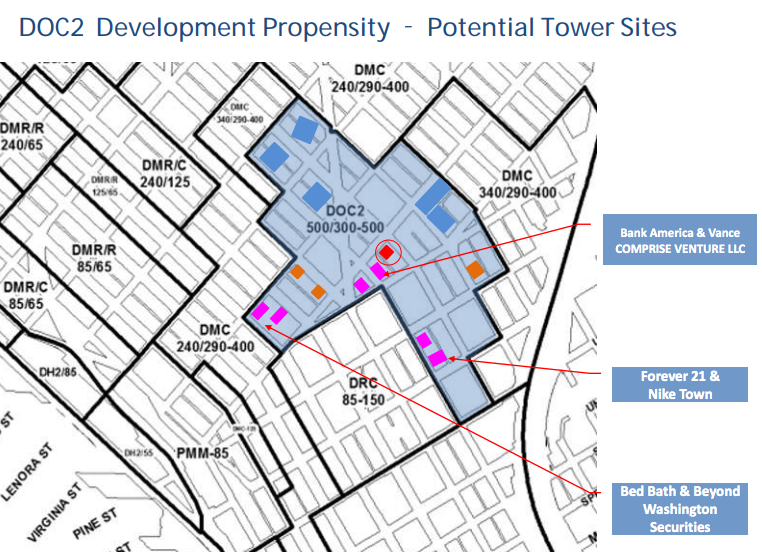
Earlier this year, the City Council passed a rezone of the Downtown and South Lake Union areas as part of the Mandatory Housing Affordability program. Residents in the Downtown Office Core 2 (DOC2) zone in Downtown were concerned that increased building heights and floor area allowances could reduce the health of the neighborhood if adequate tower separation was not provided.
The issue has been a long-standing one for local Belltown residents. In 2015, neighborhood residents voiced their objections to a new tower proposal on Fifth and Virginia. The bulk of the concerns were centered on its proximity to an existing residential tower on the other side of the alley. The concerns were particularly acute from residents in the Escala building, which is situated on Fourth and Virginia west of the alley. In that case, the developer sought to locate a tower structure immediately abutting the alley, which proposed to set the two tower structures less than 25 feet apart. The ultimate plans are still under review, but a modest increase in tower separation over the original proposal is a likely outcome.
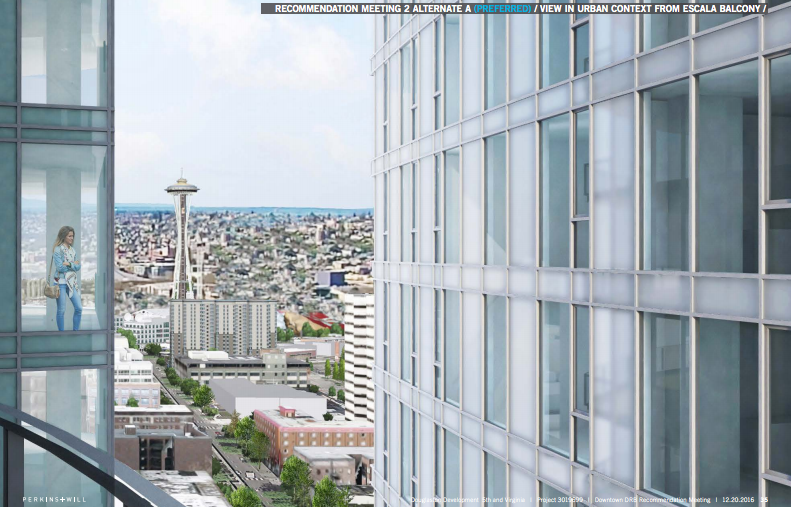
Following from this in 2016, the Downtown Residents Alliance filed an appeal against the Downtown and South Lake Union rezones because the proposal did not provide adequate provisions to deal with tower separation, particularly from existing residential towers. That appeal was eventually withdrawn with an eye toward separate legislation that would address the tower separation issue.
Sponsored by Councilmembers Sally Bagshaw (District 7, Downtown and Magnolia) and Rob Johnson (District 4, Northeast Seattle), the ordinance explicitly identifies “light” and “air” as supporting considerations for voluntary tower separation. “Increased separation from existing residential towers,” the ordinance proclaims, “can increase penetration of light and air to residences and reduce conflicts between uses in adjacent towers.” In many ways, the ordinance reflects the kind of incentives that Anton Babadjanov had suggested in exchange for providing valuable light and air to tower dwellers.
Under current law, the DOC2 500/300-550 zone allows non-residential towers up to 500 feet in height and residential towers up to 550 feet. New residential towers may exceed a building height of 300 and achieve a maximum of 550 feet if a developer voluntarily agrees to deliver affordable housing. Non-residential towers, however, may achieve the maximum 500-foot height limit without a voluntary agreement for affordable housing. The zone also has base floor area allowances and bonus floor area allowances, the latter available to developers electing to use various incentives to increase floor area. In terms of setbacks, there is no requirement in the Land Use Code for setbacks between towers, though setbacks exist for other purposes.
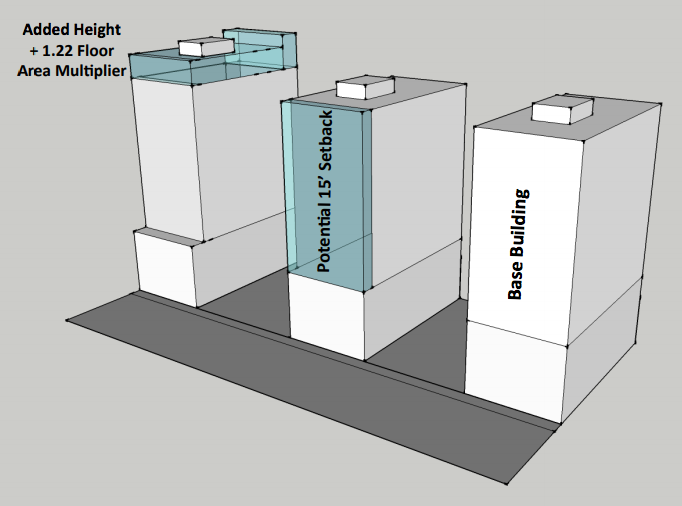
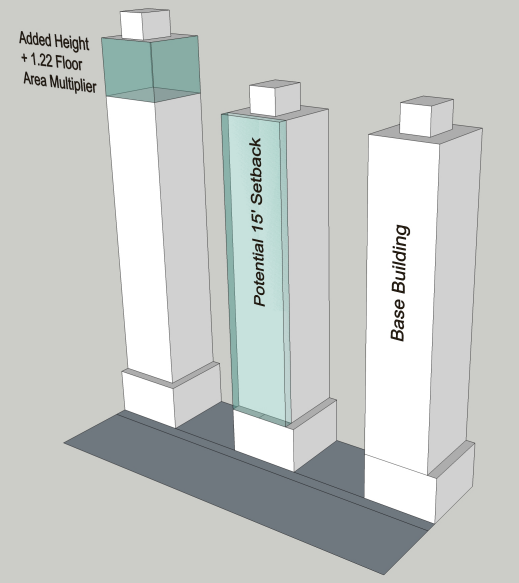
The voluntary incentives passed in the ordinance are available to both residential and non-residential towers allowing them to increase maximum building height and floor area ratio (FAR) in exchange for increased separation from existing residential towers. Non-residential uses in towers will be able to achieve an additional 0.33 FAR (the standard maximum is 15 FAR) whereas residential uses in towers will be able to achieve both an additional 0.33 FAR and 90 feet in building height (up to 640 feet), provided that the following are met:
- An adjacent existing tower is at least 160 feet in height and at least 50% of the total square footage consists of residential uses;
- The adjacent existing tower is located on an adjoining lot or is across an alley from the proposed tower when the proposed tower could be located within 22 feet of the existing tower;
- For portions of the proposed tower above 85 feet in height in residential use, the average square foot of each floor shall be no more than 11,200 square feet (the average floorplate maximum is 12,700 square feet for residential use if the tower exceeds a base height limit of 300 feet); and
- For portions of the proposed tower above 85 feet in height, the structure is setback at least 30 feet from a lot line facing an adjoining property with an existing tower or at least 15 feet from a lot line facing a lot with an existing tower across an alley (an alley is typically 16 feet to 18 feet wide).
For the purposes of the provision, an “existing tower” is considered to be a structure that physically exists or where an applicant has filed a complete Master Permit Application that is still valid or has submitted a complete application for Early Design Guidance under Design Review. The additional floor area and building height allowed by the incentive will be processed as an administrative decision by the Seattle Department of Construction and Inspections, which are not appealable to Hearing Examiner. Instead, most appeals would go to Superior Court under the Land Use Petition Act.
Land Sale of Seattle City Light Property
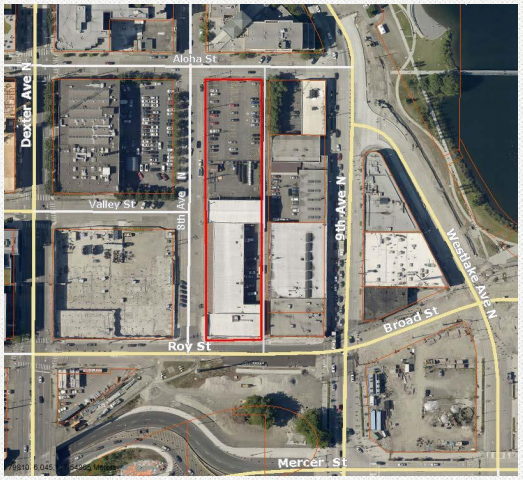
The City Council authorized sale of a Seattle City Light (SCL) property in South Lake Union with up to $10 million in proceeds earmarked for the utility’s Rate Stabilization Account. This would money would help reduce the need to increase rates in future years. Located at 8th Ave N and Roy St, the property is a long rectangular block on the eastern side of 8th Ave. Half of the site is occupied by a large landmark building.
SCL sought to begin sale in 2010, but stopped short of actually disposing it. The process to sell it began again this year with SCL notifying other departments, such as the Office of Housing, Seattle Parks and Recreation, and the Seattle Public Library. None of the agencies expressed an interest in acquiring the property since under law SCL properties must be sold at fair market value. With a price tag of $30 million (which discounts environment cleanup costs of the site), the valuation was well above what agencies were willing to pay even if there was a local need.
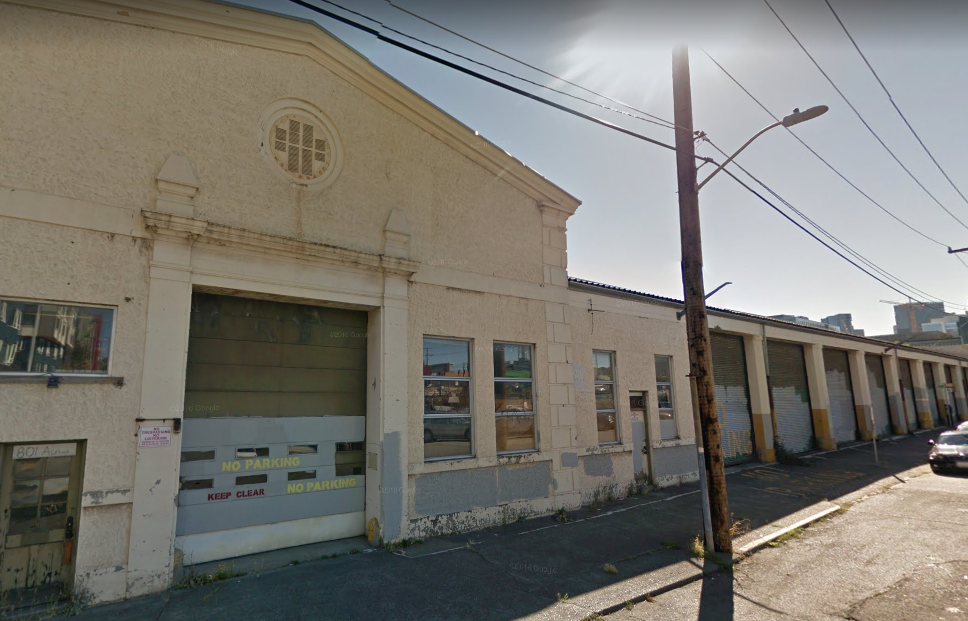
At a committee meeting last week, Tim Croll, project manager for SCL, said that his agency received many comments from the public requesting that the property be put to various public uses, including as a pool, tree reserve for carbon offset credits, school, and land trust. One issue the a community group intends to carry forward is locating a community center on the site as part of future development. Councilmember Lorena González asked if that would be feasible. Croll said that the authorizing ordinance for the land sale was “agnostic” on future use, but that it was possible if negotiated between the community, developer, and relevant City agencies.
During the meeting, Chip Nevins, a planner for Seattle Parks and Recreation, explained that his department evaluated acquisition of the property. He noted while there is a deficit of park space in Downtown and many urban centers and villages, the particular property’s location was not strategic to South Lake Union given that it is only two blocks from Lake Union Park, a major open space in the neighborhood. Nevins also said that the property price was much too high since his department only receives $2 million annually for acquisition costs. The Denny Substation, which is another property owned by SCL in South Lake Union, will provide public space, including a dog park, community meeting space, and walking loop, when complete.
Miriam Roskin from the Office of Housing said that her department also considered acquisition of the property, but again, the cost was just too high. In fact, she said that if the Office of Housing purchased, it would easily be the largest per land acquisition cost per in the agency’s portfolio with well over $100,000 per unit. The target for the Office of Housing is closer to $25,000 per unit for land. Roskin noted that there other more cost effective options that may be available in South Lake Union that the Office of Housing is actively looking at for acquisition. She also said that the Office of Housing has funded over 600 affordable housing units in South Lake Union, particularly in the Cascade district.
The property, however, was recently rezoned SM-SLU 100/95, a mixed-use mid-rise zone, as part of the Mandatory Housing Affordability program. If a developer acquires the property and redevelops it, the affordable housing requirements will kick in. SCL’s early estimates indicate that up to $3.5 million in affordable housing fees could be delivered by a project. Or alternatively, up to 22,000 square feet of affordable housing space would be created.
Stephen is a professional urban planner in Puget Sound with a passion for sustainable, livable, and diverse cities. He is especially interested in how policies, regulations, and programs can promote positive outcomes for communities. With stints in great cities like Bellingham and Cork, Stephen currently lives in Seattle. He primarily covers land use and transportation issues and has been with The Urbanist since 2014.

